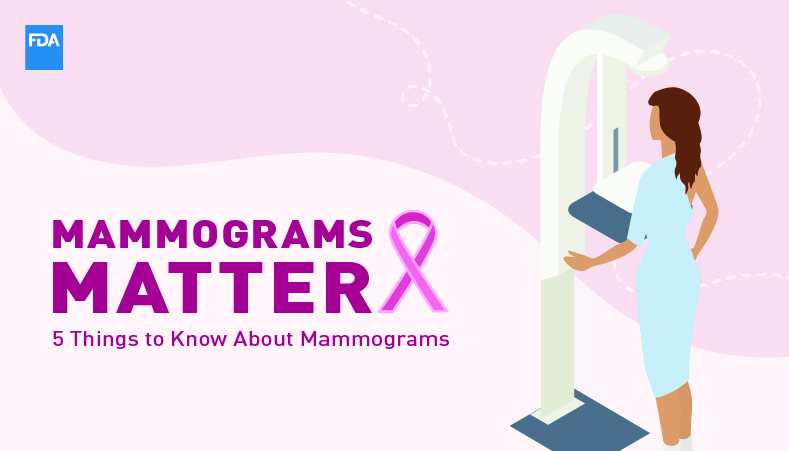Mammograms Matter: 5 Things to Know About Mammograms
Published
Courtesy of the FDA Office of Women's Health
About 1 in 8 women in the United States will get breast cancer at some point in their lives. Among those women, more than 40,000 will die from the disease. When you get a mammogram, you can improve your chances of surviving breast cancer. A mammogram can help find breast cancer early while it is small, easier to treat, and not yet causing symptoms. Here are five things you need to know about mammograms that could help save a life.
What is a mammogram?
A mammogram is a low-dose X-ray image (picture) of the breasts taken by a specially trained technologist. When you get a mammogram, several images of your breast are taken. A radiologist examines the images to see if there is anything unusual in the breasts.
Almost all mammograms in the United States are performed using digital mammography equipment. The FDA has cleared two types of digital mammograms: two-dimensional (2D) and three-dimensional (3D). You can speak with your health care provider to learn which type of mammogram is right for you.
Why should I get a mammogram?
Mammograms help save lives! They create images that can show breast lumps that are too small to feel during a breast exam. Mammograms cannot find all problems, but they are the best tool to screen for breast cancer.
Contact your health care provider if you notice any of the following in your breasts:
• A lump
• Thickening of skin
• Liquid leaking from the nipple
• Changes in how the nipple or skin looks
When should I get a mammogram?
It is important to get a mammogram on a regular basis. This is because the risk of breast cancer can vary from person to person. Talk with your health care provider about how often you should get a mammogram.
Where can I get a mammogram?
You can get a mammogram at any certified facility that meets standards set by the FDA.
What happens when you get a mammogram?
DURING YOUR APPOINTMENT:
• You will remove your clothing above your waist and put on a gown
• You will stand in front of an X-ray machine
• Your breast will be placed on a small platform
• A clear plastic plate will press down on your breast for a few seconds
◦ (You might find pressure on the breast uncomfortable)
• The technologist takes several X-ray images of your breast
AFTER YOUR APPOINTMENT:
• A radiologist looks at the X-ray images to see if there is anything that might not be normal in your breasts
• You and your health care provider should get written results within 30 days after your mammogram
• To ensure everything is normal, you can call your health care provider for your results
• Ask for a copy of your mammogram results so that you can compare them with the mammograms you get in the future
The FDA also requires facilities to tell you whether your breast tissue is dense or not dense. If you have dense breasts, you will be advised to speak to your health care provider about what this means for your risk of breast cancer. Dense breast tissue is now known as a risk factor for developing breast cancer, and it can also make cancers harder to find on a mammogram.
Share this information with women in your family, your patients, and your community to help spread the word about mammograms, with information available in multiple languages. Together, we can help all women take charge of their breast health and be screened for breast cancer sooner rather than later.
Any support or resources you'd like to share, please post in comments below!

Not a member of Healthy Nurse, Healthy Nation yet? Join today! Sign up for our monthly challenges!
What is a mammogram?
A mammogram is a low-dose X-ray image (picture) of the breasts taken by a specially trained technologist. When you get a mammogram, several images of your breast are taken. A radiologist examines the images to see if there is anything unusual in the breasts.
Almost all mammograms in the United States are performed using digital mammography equipment. The FDA has cleared two types of digital mammograms: two-dimensional (2D) and three-dimensional (3D). You can speak with your health care provider to learn which type of mammogram is right for you.
Why should I get a mammogram?
Mammograms help save lives! They create images that can show breast lumps that are too small to feel during a breast exam. Mammograms cannot find all problems, but they are the best tool to screen for breast cancer.
Contact your health care provider if you notice any of the following in your breasts:
• A lump
• Thickening of skin
• Liquid leaking from the nipple
• Changes in how the nipple or skin looks
When should I get a mammogram?
It is important to get a mammogram on a regular basis. This is because the risk of breast cancer can vary from person to person. Talk with your health care provider about how often you should get a mammogram.
Where can I get a mammogram?
You can get a mammogram at any certified facility that meets standards set by the FDA.
What happens when you get a mammogram?
DURING YOUR APPOINTMENT:
• You will remove your clothing above your waist and put on a gown
• You will stand in front of an X-ray machine
• Your breast will be placed on a small platform
• A clear plastic plate will press down on your breast for a few seconds
◦ (You might find pressure on the breast uncomfortable)
• The technologist takes several X-ray images of your breast
AFTER YOUR APPOINTMENT:
• A radiologist looks at the X-ray images to see if there is anything that might not be normal in your breasts
• You and your health care provider should get written results within 30 days after your mammogram
• To ensure everything is normal, you can call your health care provider for your results
• Ask for a copy of your mammogram results so that you can compare them with the mammograms you get in the future
The FDA also requires facilities to tell you whether your breast tissue is dense or not dense. If you have dense breasts, you will be advised to speak to your health care provider about what this means for your risk of breast cancer. Dense breast tissue is now known as a risk factor for developing breast cancer, and it can also make cancers harder to find on a mammogram.
Share this information with women in your family, your patients, and your community to help spread the word about mammograms, with information available in multiple languages. Together, we can help all women take charge of their breast health and be screened for breast cancer sooner rather than later.
Any support or resources you'd like to share, please post in comments below!

Not a member of Healthy Nurse, Healthy Nation yet? Join today! Sign up for our monthly challenges!
Blog Quality of Life
10/18/2023 3:28pm CDT



Post a Comment or Question